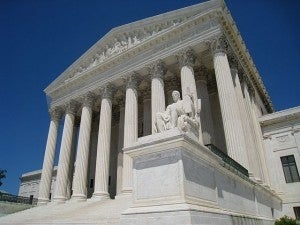
U.S. Supreme Court
If it feels like we’re being inundated with bad news about federal climate policy, here’s a cause for hope – today marks the tenth anniversary of the Supreme Court’s decision in Massachusetts v. EPA, one of the most important environmental cases in our nation’s history.
The Supreme Court’s landmark decision in Massachusetts came when the U.S. Environmental Protection Agency (EPA) under the George W. Bush administration was refusing to carry out its responsibilities under the Clean Air Act to address climate pollution.
The case arose from a petition filed in 1999 by citizens, conservation and environmental groups that asked EPA to limit climate pollution under the Clean Air Act. But under President Bush, EPA disavowed its obligation to address climate pollution. At the time, EPA relied on the dubious argument that dangerous climate pollutants emitted into the air somehow didn’t qualify as “air pollutant[s]” under the statute.
Massachusetts, states, cities and a coalition of environmental organizations – including EDF –sought judicial review of that decision, and on April 2, 2007, the Supreme Court rejected EPA’s unlawful claim, ruling that carbon dioxide and other greenhouse gases qualified as air pollutants “without a doubt … The statute is unambiguous.”
The Supreme Court also forcefully rejected the Bush EPA’s “laundry list of reasons” not to address climate pollution. The high Court held that protection of human health and the environment from air pollution under our nation’s clean air laws — including protecting the millions of Americans afflicted by the clear and present danger of climate change — must be rooted in science, not politics or expediency.
This historic Supreme Court decision settled that addressing climate pollution is EPA’s responsibility in carrying out the Clean Air Act, holding:
[G]reenhouse gases fit well within the Clean Air Act’s capacious definition of ‘air pollutant.’
Protecting Americans from climate pollution — dangerous air pollution — is the intent, is the purpose, and is provided for under our nation’s vibrant bipartisan clean air laws.
In honor of Massachusetts v. EPA’s tenth anniversary, let’s celebrate this firm and enduring Supreme Court decision and the real-world benefits it has for millions of Americans — and let’s prepare to defend the vital safeguards that followed it. We also celebrate signs of climate progress across society, such as the more than 1,000 businesses and investors that have committed to addressing climate change through implementation of the Paris Climate Agreement.
Climate Protections under Massachusetts v. EPA
As it turns ten, Massachusetts v. EPA is more relevant than ever. To carry out its responsibility to protect human health and the environment from dangerous climate pollution, EPA has established common sense limits on the pollution discharged from tailpipes, smokestacks, and oil and gas development activities. These actions are fundamental to our nation’s response to climate change and provide enormous health, economic, and environmental benefits to the American people.
Once Clean Cars Standards are fully implemented in 2025:
- Increased efficiency will provide savings of more than $8,000 in gasoline over the lifetime of a vehicle, compared to a similar vehicle in 2010. Across America, the Clean Cars Standards will save Americans more than $1 trillion at the pump.
- Americans will have saved 12 billion barrels of oil, increasing U.S. energy security.
- When new cars are purchased with financing—as they are for most Americans—the fuel savings produce immediate net benefits for American consumers.
- The auto industry has been beating these standards while adding jobs and achieving record vehicle sales.
Under EPA’s Clean Trucks Standards:
- Over the lifetime of vehicles covered by the Phase 1 Standards (model years 2014-2018), the standards will save 530 million barrels of oil and yield fuel savings of $50 billion. An operator of a large freight truck is expected to have net savings up to $73,000 over the useful life of a new truck.
- Over the lifetime of vehicles covered by the Phase 2 Standards (model years 2019-2029), the standards will reduce 1 billion tons of carbon pollution, save nearly 2 billion barrels of oil and save truck owners $170 billion in fuel costs. The Phase 2 benefits are in addition to the benefits of simply leaving the Phase 1 Standards in place.
- These fuel cost savings will save hard-earned money for truckers and U.S. consumers alike. The Consumer Federation of America found that rigorous fuel economy and climate pollution standards could save American households $250 annually in the near term and $400 annually by 2035 on goods and services.
Once the Clean Power Plan — our first and only national limits on climate pollution from existing power plants — is fully implemented:
- Americans will breathe cleaner air, which will prevent up to 3,600 premature deaths and 90,000 childhood asthma attacks every year.
- Average electric bills could decline by as much as 11 percent, due in part to cost-effective energy efficiency measures.
- Existing power plants’ carbon dioxide pollution will fall approximately 32 perent from 2005 levels. The U.S. has already achieved about two-thirds of that reduction.
Under EPA’s methane pollution standards for new oil and gas operations:
- Methane pollution will be reduced by 510,000 short tons in 2025, which has the same 20-year climate benefit as closing 11 coal-fired power plants or taking 8.5 million cars off the road.
- Less natural gas will be wasted, preserving America’s natural resources.
- These common-sense limits on methane will also reduce 210,000 tons of dangerous smog-forming pollution and 3,900 tons of toxic, carcinogenic pollutants like benzene in 2025.
- These clean air standards are extremely cost-effective.
- These standards will also boost America’s vibrant methane mitigation industry—which is already creating jobs and investment in at least 500 different locations across 46 states, especially in major energy-producing states like Texas, Oklahoma, Ohio, and Pennsylvania.
The protections that flow from Massachusetts v. EPA are helping to yield a safer climate for our children, protect the health of our communities, save energy and money for families across America, and build a prosperous clean energy economy. It is not surprising that these safeguards have broad support across red, blue and purple America. In every Congressional district, a majority of adults supports limiting carbon dioxide emissions from existing coal-fired power plants.
Scott Pruitt Is Evading his Obligations under Massachusetts v. EPA
Unfortunately, EPA Administrator Scott Pruitt is trying to evade his obligation to address climate pollution. Since taking his oath as Administrator, Pruitt has repeatedly tried to sow doubt as to whether climate pollution should be regulated under the Clean Air Act — demonstrating a profound disregard for the Supreme Court’s holding in Massachusetts.
Make no mistake – EPA’s obligation to address climate pollution under the Clean Air Act is a settled question in American law.
Climate Pollution Meets the Definition of “Air Pollutant” under the Clean Air Act
Under the Bush Administration, EPA argued that climate pollutants could not be “air pollutants” under the Clean Air Act on the convoluted grounds that “EPA lacks regulatory authority to address global climate change.”
But in Massachusetts, the Supreme Court held that “the Clean Air Act’s sweeping definition of ‘air pollutant’” clearly authorizes EPA to regulate climate pollution.
Moreover, the Court recognized that the Clean Air Act was intentionally written with “broad language … to confer the flexibility necessary to” meet challenges like climate pollution, and EPA cannot dodge its obligations with “policy judgments … [that] have nothing to do with whether greenhouse gas emissions contribute to climate change.”
In other words, EPA has to base its actions on law and science, not politics.
Massachusetts involved a petition to regulate pollution from motor vehicles, but the Supreme Court has repeatedly affirmed that climate pollution from other sectors, including power plants, is also subject to Clean Air Act regulation.
In American Electric Power v. Connecticut (AEP), the Court determined:
Massachusetts made plain that emissions of carbon dioxide qualify as air pollution subject to regulation under the Act … And we think it equally plain that the Act ‘speaks directly’ to emissions of carbon dioxide from the … [power] plants.
The Court went on to identify a specific section of the Clean Air Act under which EPA could issue such protections. EPA subsequently finalized pollution limits — including the historic Clean Power Plan — under that very section.
A few years after AEP, in Utility Air Regulatory Group v. EPA, the Court stood by its finding that the Clean Air Act covered climate pollution from power plants and held that new and modified industrial facilities must also limit their climate pollution.
Administrator Pruitt has publicly doubted whether EPA has the “tools” under the Clean Air Act to address climate change. This is just a feeble variation of the George W. Bush Administration’s stale claim rejected by the Supreme Court a decade ago. In fact, the Supreme Court has recognized that multiple programs under the Clean Air Act are suitable for addressing climate pollution — and EPA has adopted several achievable, common-sense climate safeguards that are already protecting American communities while supporting cost-saving efficiencies. Administrator Pruitt is invoking long-discredited arguments to avoid responsibility for addressing life-threatening pollution.
The Science of Climate Change is Clear
A few weeks ago, Administrator Pruitt told CNBC that he “would not agree that [carbon dioxide is] a primary contributor to the global warming that we see.”
But as far back as Massachusetts, the Supreme Court found that “[a] well-documented rise in global temperatures has coincided with a significant increase in the concentration of carbon dioxide in the atmosphere” as recognized by “[r]espected scientists” and called carbon dioxide “the most important species … of a ‘greenhouse gas.’”
Following Massachusetts, EPA initiated a rigorous, scientific, peer-reviewed analysis of the effects of carbon dioxide and five other climate pollutants. In 2009, after reviewing an expansive body of scientific evidence reflecting hundreds of peer reviewed studies, EPA determined that the pollutants:
[M]ay reasonably be anticipated to endanger public health and to endanger public welfare.
EPA’s determination, or Endangerment Finding, was resoundingly upheld in the U.S. Court of Appeals for the District of Columbia Circuit in Coalition for Responsible Regulation v. EPA, based largely on the “substantial record evidence that anthropogenic emissions of greenhouse gases ‘very likely’ caused warming of the climate over the last several decades.”
In the CNBC interview, Administrator Pruitt offered no evidence to support his views about carbon dioxide and climate change. That’s unsurprising because the scientific evidence is not on his side. As EPA observed in its 2015 carbon dioxide standards for new power plants, since the Endangerment Finding was finalized:
The facts, unfortunately, have only grown stronger and the potential adverse consequences to public health and the environment more dire.
The science overwhelmingly shows that climate pollution is causing dangerous climate change. EPA has a statutory obligation to address it under the Clean Air Act.
The Clean Air Act is a Statute to Protect Public Health and the Environment
Massachusetts prohibited EPA from touting “some residual uncertainty” about climate science as an excuse for inaction. EPA must act if it can “mak[e] a reasoned judgment” that “greenhouse gases contribute to global warming.”
When a three-judge panel of the D.C. Circuit unanimously upheld EPA’s Endangerment Finding, it explained that the Clean Air Act’s:
[L]anguage requires a precautionary, forward-looking scientific judgment about the risks of a particular air pollutant, consistent with the [Act’s] precautionary and preventive orientation. Requiring that EPA find ‘certain’ endangerment of public health or welfare before regulating greenhouse gases would effectively prevent EPA from doing the job Congress gave it. (internal citations omitted)
The science, which was already clear when the Supreme Court decided Massachusetts in 2007, has only grown clearer in the intervening decade. For instance:
- Since record keeping began in 1880, the five hottest years globally have all occurred since 2007.
- Sea levels have risen at increasing rate.
- The ten summers with the lowest minimum Arctic sea ice extent coincide exactly with the ten summers since Massachusetts was decided. And 2017 has already attained a grim status as the third consecutive year with a record low extent of winter Arctic sea ice.
- In February 2007, atmospheric carbon dioxide averaged 383.90 parts per million. In February 2017, it averaged 406.42 ppm. The years 2015 and 2016 saw the two biggest annual increases ever recorded.
The Clean Air Act does not require us to watch idly as coastlines disappear, increased instanced of extreme weather such as severe flooding and superstorms cause loss of life and alter lives forever, and more frequent heatwaves threaten vulnerable populations like children and the elderly. It requires action. EPA has an obligation to act to protect public health and the environment by addressing climate pollution in order to reduce the tragic consequences of climate change, which are already unfolding.
The Legacy of Massachusetts v. EPA
Ten years on, Massachusetts v. EPA stands for EPA’s responsibility to address climate change based on law and science. Massachusetts also stands for the ability — and the imperative — to achieve victories for public health and the environment under adverse political conditions. With Administrator Pruitt at the helm of environmental policymaking in the U.S., we have no illusions about the challenges that lie ahead. But there will also be opportunities – opportunities to secure near-term reductions of dangerous pollution, and opportunities to lay the foundation for more progress in the years ahead, all anchored in law and science.
We can’t afford to let climate change accelerate unchecked for the next four years, and Massachusetts inspires us to keep working to protect all Americans from this clear and present danger.
 Our remarks were sandwiched between aggressive statements from the Utility Air Regulatory Group (UARG), a group of coal-based power companies, and the American Petroleum Institute (API).
Our remarks were sandwiched between aggressive statements from the Utility Air Regulatory Group (UARG), a group of coal-based power companies, and the American Petroleum Institute (API).














